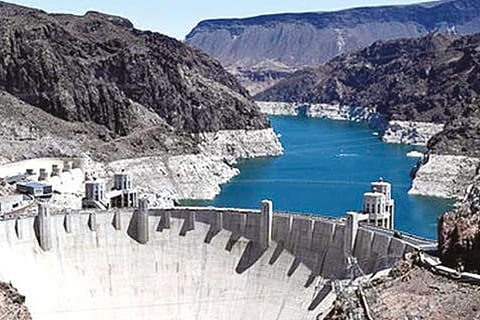

Chennai
This year, droughts made more frequent and severe by rising temperatures have caused the biggest drops in hydropower generation recorded for decades. At Lake Mead, not far from the US metropolis of Las Vegas, the Colorado River feeds the Hoover Dam, which supplies water to more than 140 million people in America. But right now, the vast reservoir is just one-third full.
Declining levels mean the dam’s power plant produced 25% less electricity this July than would usually be the case. They have also prompted the US federal government to announce water cuts to towns downstream of the dam starting in January 2022. In South America, it’s a similar situation. The Parana River, which flows through Brazil, Paraguay and Argentina, is experiencing extremely low levels of water. Southern Brazil, where the Parana rises, has been in the grip of severe drought for three years.
According to local reports, levels in reservoirs in central and southern Brazil have dropped by more than half the average of the past 20 years, and are currently at just under a third of their capacity. As Brazil generates about 60% of its electricity from hydropower, continued low dam levels could lead to blackouts. To prevent that from happening, Brazilian authorities have begun reactivating natural gas power plants, which is causing electricity prices, as well as greenhouse gas emissions, to rise.
But it’s not only drought that can cripple hydroelectric power generation. Heavy rain and flooding can also pose major problems. In March 2019, severe flooding following Cyclone Idai, which struck western Africa, damaged two major plants in Malawi, cutting off power to parts of the country for several days. In several African countries, including the Democratic Republic of Congo, Ethiopia, Malawi and Mozambique, hydropower accounts for more than 80% of electricity generation, according to the International Energy Agency (IEA). Overall, hydropower accounted for about 17% of electricity in Africa at the end of 2019. That figure is forecast to rise to more than 23% by 2040.
But according to the IEA, most new plans for hydropower plants in Africa do not adequately take into account the potential hazards of climate change, if they consider them at all. Meanwhile, many hydropower plants already in operation around the world are facing another problem — aging. According to a United Nations University study, dams reach the end of their useful life 50 to 100 years after construction. The more these structures weather, the study notes, the more likely dam failure becomes. From as early as 25-35 years into a dam’s lifetime, the measures needed to maintain it significantly increase the operating costs, the authors said. With that in mind, it would be disastrous to invest in more hydropower plants while phasing out fossil fuels, says Thilo Papacek from CounterCurrent, a German NGO that campaigns for socially and environmentally responsible foreign involvement from German organisations abroad.
Klement Tockner, director general of the Senckenberg Society for Nature Research and a professor of ecosystem science at Goethe University in Frankfurt believes they should not be built in existing protected areas where there are still sufficient free-flowing rivers and says that where appropriate, measures should be put in place to offset the negative impacts of hydropower plants on ecosystems — such as the restoration of impaired waterways and the removal of dams. New plants need to be built in such a way that rivers are still as permeable as possible — both to let fish and sediment to travel up and downstream, and to allow the flow of large volumes of water during floods.
This article was provided by Deutsche Welle
Visit news.dtnext.in to explore our interactive epaper!
Download the DT Next app for more exciting features!
Click here for iOS
Click here for Android